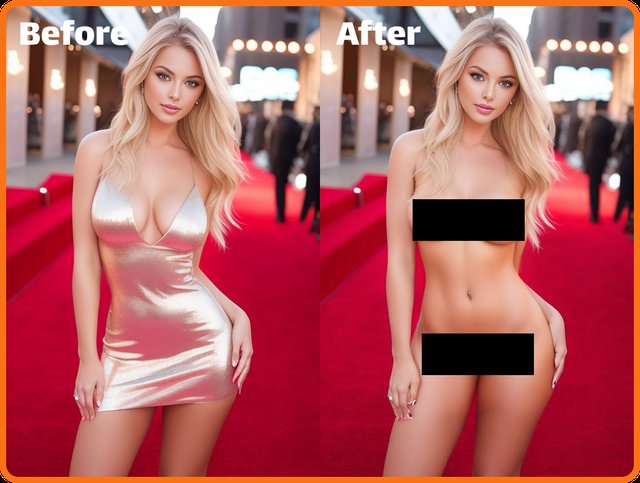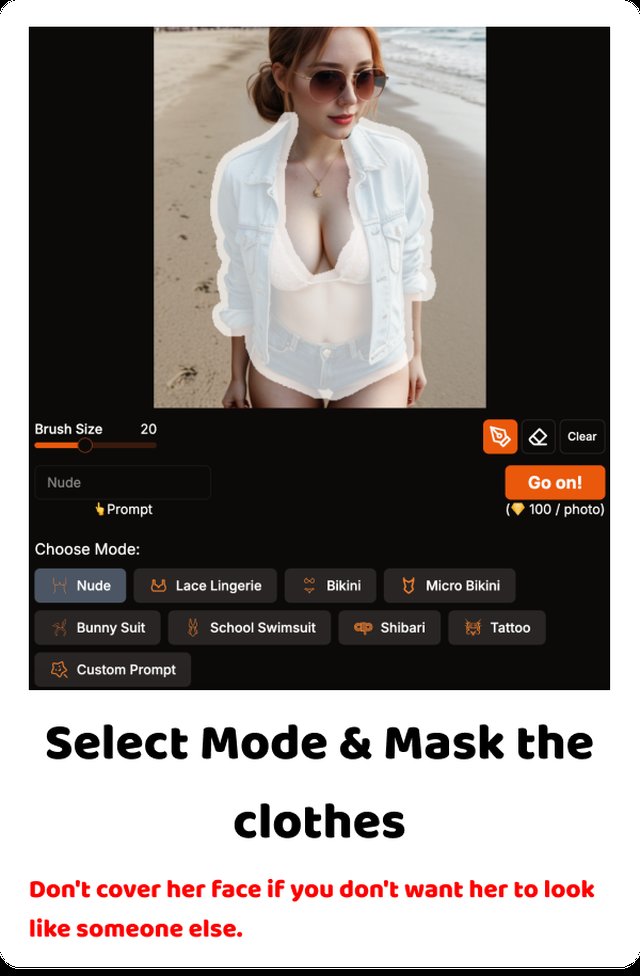Beginner’s Guide to Image Nudify
The concept of “image nudify,” often associated with using artificial intelligence (AI) to alter images and simulate nudity digitally, has gained attention in recent years and while the technology showcases the power of AI, it also presents significant ethical challenges. This guide aims to explain the workings of image nudify tools, their applications, and the importance of understanding both their potential benefits and inherent risks.
Contents
- Beginner’s Guide to Image Nudify
- What is Image Nudify?
- How to use Image Nudify?
- Step 1: Upload Image
- Step 2: Select Mode & Mask the clothes
- Step 3: Click "Go On!" & Waiting
- Step 4: Complete!
- How Does Image Nudify Technology Work?
- Applications of Image Nudify Technology
- Ethical Concerns and Risks
- Importance of Consent and Ethical Usage
- Preventing Misuse: Measures for Developers and Policymakers
- Alternatives to Image Nudify Technology
- The Future of Image Nudify Technology
- Conclusion
- FAQs
- 1. Is image nudify technology illegal to use?
- 2. Can nudify tools detect or block misuse?
- 3. What are the risks of using image nudify software?
What is Image Nudify?

Image nudify refers to using AI to manipulate photographs or digital images, typically by adding or altering visual elements to simulate nudity. These tools often employ machine learning algorithms trained on extensive datasets of human anatomy to predict and generate realistic renditions of skin textures and body shapes. While some might view this technology as a novelty or creative tool, its misuse raises critical concerns around privacy, consent, and digital ethics.
How to use Image Nudify?
Step 1: Upload Image

Upload an image of a clothed person. The image should be clear and of good quality.
Step 2: Select Mode & Mask the clothes

Select the mode and mask the clothes. The mode can be 'Nude' or other. The mask is used to remove the clothes from the image. You can either use the default mask or modify it to your liking.
Step 3: Click "Go On!" & Waiting

Click "Go On!" and wait for the image to be processed. This might take a few seconds.
Step 4: Complete!

Once the image is processed, you can download the image by clicking "Save".
How Does Image Nudify Technology Work?
At its core, image nudify technology relies on deep learning algorithms and generative adversarial networks (GANs). Here’s a breakdown of the process:
- Image Input: The user provides a base image, often a clothed individual, for processing.
- Analysis: The AI analyzes the image, focusing on factors such as body shape, skin tone, and posture.
- Prediction: Using pre-trained models, the AI predicts how the unclothed version of the individual might appear based on learned patterns.
- Generation: The GANs generate the altered image by filling in missing visual data with realistic-looking textures and tones.
While the technology appears advanced, its results are highly dependent on the quality of the input image and the sophistication of the algorithm.
Applications of Image Nudify Technology
Image nudify tools have potential applications across various fields, though many remain controversial. Here are a few areas where the technology might be used:
- Artistic and Creative Projects: Digital artists might use nudify technology to create lifelike renderings or experimental art pieces that push the boundaries of traditional media.
- Medical Visualization: In healthcare and anatomy education, such technology could help create visual aids that simulate different body conditions or anatomical structures.
- Costume and Fashion Design: Designers can use AI tools to simulate how garments appear on the body, aiding in the design process without requiring live models.
- Entertainment Industry: In filmmaking and gaming, AI can be utilized to generate hyper-realistic avatars or digital doubles, sometimes involving nudified imagery.
While these applications demonstrate legitimate uses, the technology’s misuse often overshadows its benefits.
Ethical Concerns and Risks
The most pressing issue surrounding image nudify technology is its misuse, especially in creating non-consensual deepfake content and here are some of the major ethical concerns:
- Violation of Privacy: Using someone’s image without their consent to generate nudified content infringes on their privacy rights and can lead to severe emotional and reputational harm.
- Objectification: The technology risks perpetuating objectification, reducing individuals to their physical appearances in ways they may not consent to.
- Cyber Harassment and Blackmail: Deepfake nudified images have been weaponized for harassment, blackmail, and cyberbullying, creating significant psychological trauma for victims.
- Reinforcement of Gender Stereotypes: The datasets used to train these algorithms often reflect societal biases, potentially reinforcing harmful stereotypes about body image and gender norms.
- Legal Implications: Laws concerning deepfakes and image manipulation vary widely across jurisdictions, making it difficult to address these issues uniformly and the victims often face challenges in seeking legal recourse.
Importance of Consent and Ethical Usage
Consent is the cornerstone of ethical image manipulation. Whether for artistic purposes or technological experimentation, ensuring that individuals have granted explicit permission for their images to be altered is crucial. Ethical guidelines should include:
- Transparency: Informing users about how their images will be processed and stored.
- User Agreements: Implementing strict consent protocols in software to prevent misuse.
- Usage Limitations: Restricting the application of the technology to verified, ethical projects.
Preventing Misuse: Measures for Developers and Policymakers
Developers and policymakers play a vital role in curbing the misuse of image nudify technology and here are some measures that can be taken:
- Improved AI Filtering: Develop algorithms that detect and block attempts to create non-consensual content.
- Regulatory Frameworks: Establish legal guidelines that specifically address the creation and distribution of nudified images without consent.
- Awareness Campaigns: Educate the public about the ethical implications of using such tools and the consequences of misuse.
- Content Reporting Systems: Implement mechanisms for victims to report and request the removal of manipulated content.
Alternatives to Image Nudify Technology
For those interested in exploring the creative potential of AI without ethical concerns, numerous alternative tools can be used. These include:
- AI-Powered Illustration Tools: Create lifelike or abstract art without involving sensitive content.
- 3D Modeling Software: Tools like Blender allow users to simulate realistic human anatomy for educational and creative purposes.
- Virtual Fashion Design: Applications like CLO 3D enable designers to visualize clothing on digital avatars without altering real images.
The Future of Image Nudify Technology
As AI continues to evolve, so too will the capabilities of image nudify technology. The future might see:
- Enhanced Realism: With advancements in GANs, these tools could produce even more lifelike results.
- Stronger Safeguards: Ethical AI development could lead to built-in safeguards against misuse.
- Broader Applications: From virtual reality to advanced simulations, image nudify tools might find applications in unexpected industries.
However, the trajectory of this technology depends largely on the collective efforts of developers, users, and regulators to prioritize ethical considerations.
Conclusion
As AI continues to reshape the digital landscape, fostering a culture of consent, accountability, and responsibility is essential to ensure that innovations like image nudify benefit society without causing harm.
FAQs
1. Is image nudify technology illegal to use?
The legality of using image nudify tools depends on the context and jurisdiction. Creating or distributing manipulated images without the explicit consent of the individual involved is often considered illegal and unethical in most countries. Laws such as those targeting revenge porn, cyber harassment, or defamation may apply. Always check local regulations and prioritize ethical usage.
2. Can nudify tools detect or block misuse?
Some advanced tools incorporate safeguards to detect and block inappropriate or non-consensual use, such as requiring user verification or limiting access to specific features. However, many tools lack these protections, making misuse a widespread problem. Developers are increasingly encouraged to integrate robust ethical measures into such technologies.
3. What are the risks of using image nudify software?
The risks include potential legal consequences, violating someone’s privacy, and contributing to harassment or cyberbullying. Misuse of these tools can lead to severe reputational damage for victims and societal harm. Additionally, using unreliable software might expose users to malware, data theft, or privacy violations from the creators of such tools.